In the intricate dance between businesses and their audiences, online lead generation takes center stage as the choreographer of success. Whether you're an entrepreneur launching a startup or a seasoned marketer aiming to refine your tactics, understanding the fundamentals of lead generation is essential for driving growth and fostering meaningful customer relationships.
Welcome to a journey of discovery and mastery of inbound lead generation– a journey through the nuances and strategies of achieving online success. In this comprehensive beginner's guide, we'll delve into the dynamic world of lead generation and uncover the power of adopting an inbound approach. We'll explore how businesses can organically attract, engage, and convert potential customers, setting the stage for sustainable success in an ever-evolving marketplace.
Get Your Guide to Inbound Leads Now!
- Increased Revenue
- Targeted Audience
- Builds Customer Relationships
What Is An Inbound Lead?
An inbound lead refers to a potential customer or prospect who has shown genuine interest in your products, services, or content through their own initiative. In other words, an inbound lead is someone who has taken proactive steps to engage with your brand, often by interacting with your online content, website, or marketing materials. For example:
- Downloads an eBook or guide
- Reaches out to the sales team after reading a blog
- Expresses interest in a product demo subsequent to viewing a webinar
- Completes a survey form to provide valuable insights
Inbound leads are typically individuals who have voluntarily entered your sales funnel by expressing curiosity, seeking information, or indicating a potential need for what your business offers. These leads are more likely to be receptive to your messaging and have a higher potential to convert into paying customers compared to leads generated through outbound methods, which involve more interruptive forms of marketing.
There are 2 types of inbound leads:
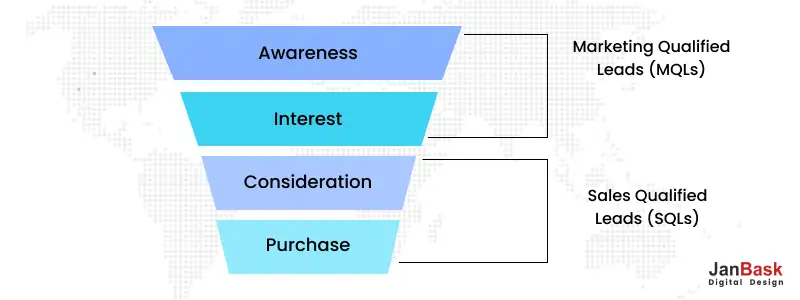
1. Marketing Qualified Leads (MQL)
- MQLs are leads that have shown a certain level of interest or engagement with your brand's marketing efforts.
- They might have downloaded resources, subscribed to your newsletter, attended webinars, or interacted with your social media content.
- MQLs are still in the early stages of the buying process, where they are gathering information and exploring potential solutions.
- These leads require further nurturing and targeted marketing efforts to move them closer to a sales-ready state.
2. Sales Qualified Leads (SQL)
- SQLs are leads that have been thoroughly vetted and have demonstrated a higher likelihood of converting into paying customers.
- They have engaged in more direct interactions with your brand, such as requesting product demos, pricing information, or consultations.
- SQLs typically have a clear understanding of their needs and are actively evaluating your product or service as a potential solution.
- These leads are considered ready for direct sales engagement and are passed on to the sales team for further action.
The distinction between MQLs and SQLs helps sales and marketing teams prioritize their efforts and allocate resources effectively. While MQLs require nurturing and education, SQLs demand personalized and timely interactions to move them along the sales funnel and convert them into customers.
What Is Inbound Lead Generation?
Inbound lead generation is a strategic approach to attracting and engaging potential customers by providing valuable and relevant content, experiences, and interactions. Unlike traditional outbound methods, which often involve interruptive advertising and cold outreach, inbound lead generation focuses on creating a magnet-like effect, where interested prospects are drawn to your brand naturally.
At the core of inbound lead generation is the concept of building trust and establishing a meaningful relationship with your target audience. This approach is based on the understanding that modern consumers are well-informed, empowered, and prefer to engage with brands that offer genuine value.
Curious how to generate leads? Our company specializes in providing top-notch lead generation services to help businesses expand their customer base.
Why Do You Need Inbound Lead Generation?
Inbound lead generation is essential for fostering genuine customer connections and driving sustainable business growth in today's dynamic digital landscape. Here are more reasons for doing so:
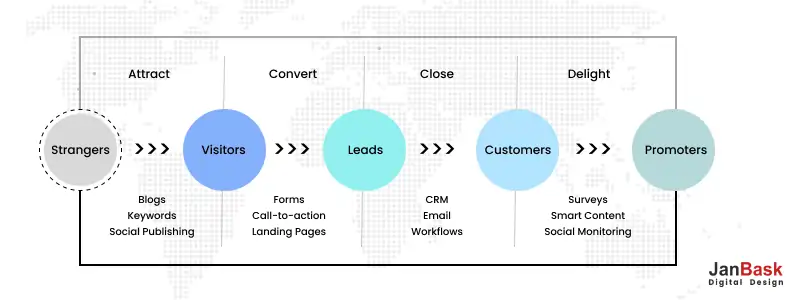
- Attracts high-quality leads organically, resulting in more qualified prospects.
- Builds brand credibility and authority through valuable content and engagement.
- Establishes a customer-centric approach, focusing on meeting the needs and preferences of potential customers.
- Nurtures long-lasting relationships by providing relevant and personalized interactions.
- Reduces marketing costs by focusing on targeted strategies that yield better results.
- Increases conversion rates by engaging leads who are genuinely interested in your offerings.
- Aligns with modern consumer behavior, where individuals actively seek information before making purchasing decisions.
- Provides valuable data and insights to refine marketing strategies based on audience preferences.
- Creates a sustainable and scalable online lead generation process, generating ongoing business opportunities.
The Process Of Lead Generation
Having grasped the role of sales lead generation within the framework of inbound marketing, let's now delve into the sequential stages of the lead generation process.

- To commence, a visitor stumbles upon your business via one of your marketing channels, which could be your website, blog, or social media platform.
- Subsequently, this visitor engages with your call-to-action (CTA) – a visual element, button, or message enticing website visitors to initiate a specific action.
- The CTA then redirects the visitor to a landing page, a dedicated web page intentionally designed to gather lead details in exchange for a valuable offer.
- Once the visitor arrives at the landing page, they complete a form, trading their information for the offered content. Voilà! A new lead is acquired, provided you adhere to the best practices of lead capture.
Lead Generation Marketing: Unveiling Effective Strategies
Businesses can attract, engage, and convert potential customers into valuable leads by employing a combination of strategic approaches. Let's delve into the intricacies of lead generation marketing strategies, including content marketing, email campaigns, ads and retargeting blogging, and social media engagement.
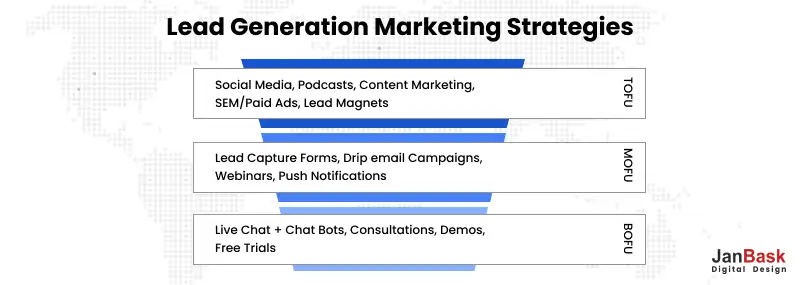
1. Content Marketing: Delivering Value and Insight
Content marketing serves as the foundation of online lead generation, focusing on providing valuable and relevant content to your target audience. By addressing their pain points, answering their questions, and offering insights, you position your brand as an authority and build trust, enticing visitors to become leads.
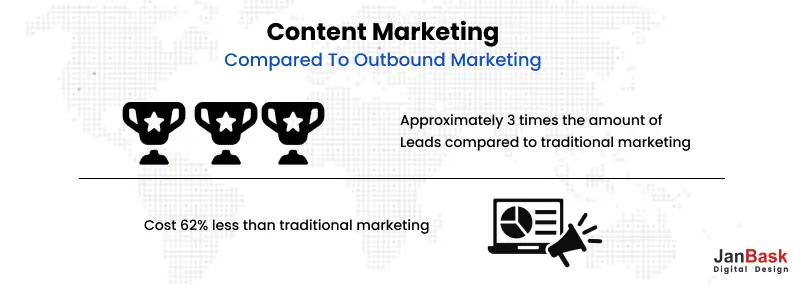
- Educational Blog Posts: Create informative blog posts that address industry challenges, share best practices, and provide solutions to common problems.
- Ebooks and Whitepapers: Develop in-depth resources that offer comprehensive guides, research findings, or step-by-step instructions, requiring visitors to provide their contact information to access valuable content.
- Videos and Webinars: Leverage visual content to engage your audience, offering webinars or video tutorials that showcase your expertise and engage viewers.
Learn how to generate quality leads through strategic content marketing, personalized engagement, and data-driven tactics.
2. Email Campaigns: Personalized Communication
Email remains a powerful tool for nurturing leads and guiding them through the buyer's journey. Effective email campaigns provide personalized content that resonates with each lead's specific needs and interests.

- Lead Nurturing Sequences: Design automated email sequences that deliver targeted content based on a lead's interactions, moving them closer to conversion over time.
- Segmentation: Divide your email list into segments based on demographics, behavior, or preferences, enabling tailored communication that resonates.
3. Ads and Retargeting: Staying Top of Mind
Paid advertising, coupled with retargeting, helps keep your brand in front of potential leads even after they leave your website, increasing the likelihood of conversion.
- Google Ads and Social Ads: Launch targeted ad campaigns on search engines and social media platforms to reach specific demographics and interests.
- Retargeting Ads: Display ads to users who previously visited your website, reminding them of your offerings and encouraging them to return.
As a reputable online marketing company, we leverage innovative techniques to enhance your brand's online presence and drive growth. Our comprehensive digital marketing services encompass SEO, social media, and content creation to maximize your online visibility.
4. Blogging: Engaging and Informing
Blogging not only fuels your content marketing efforts but also serves as a platform for engaging with your audience and showcasing your industry knowledge.
- Thought Leadership: Share your unique perspectives and insights on industry trends, demonstrating your expertise and building credibility.
- CTA Integration: Include call-to-action (CTA) buttons or links within your blog posts, directing readers to relevant lead capture forms or landing pages.
5. Social Media Engagement: Building Relationships
Social media platforms offer a dynamic space to connect with your audience, share content, and initiate conversations.
- Content Sharing: Distribute your blog posts, videos, and other valuable content across social media platforms to reach a wider audience.
- Engagement: Respond to comments, messages, and interactions promptly, fostering genuine connections and demonstrating your commitment to customer engagement.
6. Product Trials: Inviting Hands-On Experience
Offering product trials allows potential customers to experience your offerings firsthand, creating a tangible connection and promoting confidence in your solutions.
- Free Trials: Provide a limited-time trial period for your product or service, allowing leads to explore its features and benefits.
- Freemium Models: Offer a basic version of your product for free, encouraging users to upgrade to a premium version for enhanced features.
7. Referral Marketing: Leveraging Word-of-Mouth Power
Harnessing the power of referrals empowers your existing customers to become brand advocates, driving new leads to your business.
- Referral Programs: Incentivize customers to refer friends and colleagues by offering discounts, rewards, or exclusive content.
- User-Generated Content: Encourage customers to share their experiences on social media or review platforms, amplifying your brand's reach.
8. Event Marketing: Creating Engaging Experiences
Hosting or participating in events provides opportunities for direct engagement, networking, and showcasing your brand's expertise.
- Webinars and Workshops: Offer informative online sessions that address industry challenges and demonstrate your solutions.
- Trade Shows and Conferences: Participate in relevant industry events to connect with potential leads and establish your brand's presence.
9. Partner Marketing: Collaborative Outreach
Partnering with complementary businesses expands your reach and introduces your brand to new audiences.
- Joint Webinars: Co-host webinars with partners to offer comprehensive insights and expertise to a combined audience.
- Cross-Promotions: Collaborate on marketing campaigns or offers that benefit both your brand and your partner.
10. Community Building: Fostering Engagement and Loyalty
Building a community around your brand fosters a sense of belonging and encourages interaction among like-minded individuals.
- Online Forums or Groups: Create platforms where customers and prospects can engage in discussions, share insights, and seek advice.
- User-Generated Content Contests: Run contests that encourage users to create and share content related to your brand, products, or industry.
Each of these online lead-generation strategies contributes to a well-rounded marketing approach that captures attention, nurtures relationships, and guides leads toward conversion. As you tailor and integrate these tactics into your overall marketing plan, remember that understanding your target audience's preferences, needs, and behavior is crucial. By continually analyzing data, optimizing your strategies, and remaining responsive to your audience, you can refine your lead-generation efforts and cultivate a robust pipeline of potential customers.
Lead Generation Strategies Across Different Platforms
In the ever-evolving landscape of sales lead generation, harnessing the potential of various platforms is essential for reaching and engaging your target audience. Let's explore detailed strategies for lead generation on different platforms, including Facebook, Twitter, LinkedIn, Pay-Per-Click (PPC), and Business-to-Business (B2B) contexts.
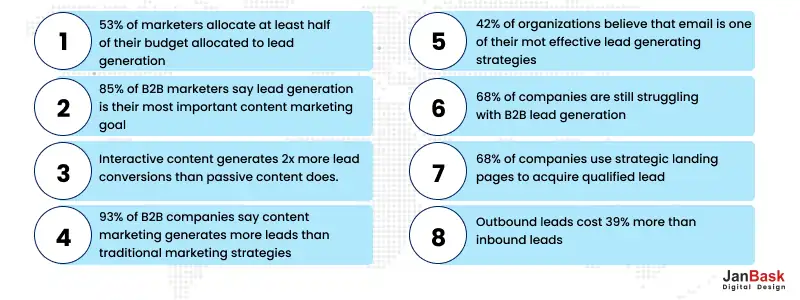
1. Facebook Lead Generation: Fostering Engagement and Connections
Facebook offers a wide range of tools and features that can be leveraged to capture and nurture leads effectively.
- Lead Ads: Utilize Facebook's lead ad format to create quick and seamless sign-up experiences, reducing friction and increasing conversions.
- Compelling Visuals: Use eye-catching images or videos in your ads to capture users' attention and highlight your offerings.
- Engagement Campaigns: Run contests, quizzes, or polls to encourage interaction, gather user data, and build a relationship with potential leads for business.
- Messenger Bots: Implement chatbots to engage with users in real-time, answer queries, and guide them through the lead generation process.
2. Twitter Lead Generation: Crafting Impactful Engagement
Twitter's fast-paced environment requires concise yet compelling content to attract and convert leads.

- Promoted Tweets: Boost tweets with valuable content, such as blog posts, infographics, or videos, to increase visibility among your target audience.
- Hashtag Campaigns: Create and promote branded hashtags that align with your lead generation goals, encouraging users to engage and share.
- Direct Messaging: Use Twitter's direct messages to initiate personalized conversations, provide information, and guide users towards becoming leads.
3. LinkedIn Lead Generation: Building Professional Relationships
LinkedIn's business-focused environment makes it a powerful platform for B2B lead generation and professional networking.
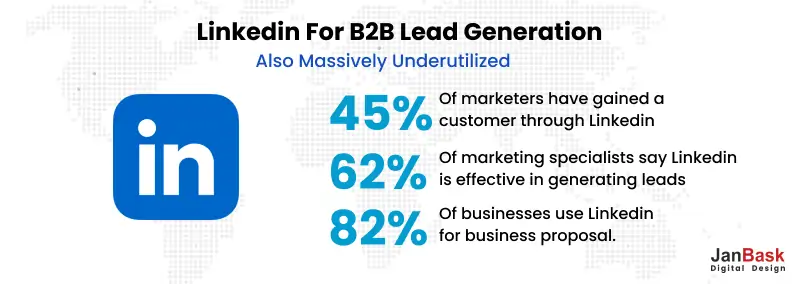
- LinkedIn Lead Gen Forms: Utilize lead generation forms within sponsored content or InMail campaigns, capturing user data without requiring them to leave the platform.
- Thought Leadership Content: Share insightful articles, industry trends, and thought-provoking posts to establish your brand as an authority in your field.
- Connect and Engage: Build connections by reaching out to relevant professionals, joining groups, and participating in discussions to expand your network.
4. PPC Lead Generation: Targeted and Results-Driven
Pay-Per-Click advertising offers precise targeting options to drive leads for business with high intent.
- Keyword Research: Conduct thorough keyword research to identify terms that resonate with your target audience and align with their search intent.
- Landing Page Optimization: Design dedicated landing pages with compelling copy and clear calls-to-action (CTAs) that match the ad's message.
- A/B Testing: Continuously test different ad variations, headlines, visuals, and CTAs to optimize your PPC campaigns for better lead conversion rates.
5. B2B Lead Generation: Nurturing Business Relationships
B2B lead generation involves building trust and credibility within the professional realm.
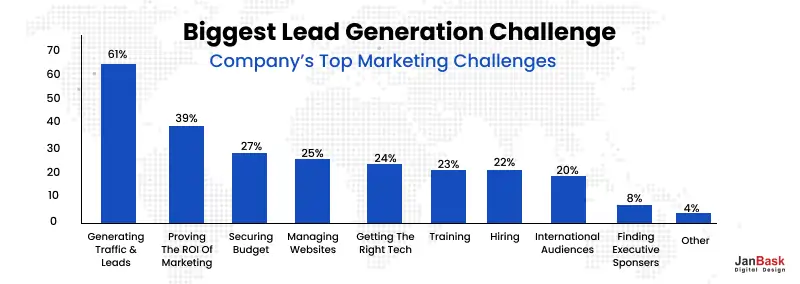
- Educational Webinars: Host webinars that address industry challenges, provide solutions, and position your brand as an expert resource.
- Case Studies and Testimonials: Showcase successful client stories to demonstrate the value and impact of your products or services.
- LinkedIn Outreach: Utilize LinkedIn to connect with decision-makers, share valuable insights, and initiate meaningful conversations.
We offer tailored B2B web design services that cater to the unique needs and preferences of businesses in the professional sector.
Tips For Lead Generation Campaigns
Creating effective sales lead-generation campaigns requires a strategic approach that combines creativity, data-driven insights, and a deep understanding of your target audience. Here are some valuable tips to help you launch successful lead-generation campaigns:
- Define Clear Goals: Set specific and measurable goals for your lead generation campaign. Are you aiming to increase website sign-ups, webinar registrations, or product demo requests? Clear objectives guide your strategy and help measure success.
- Know Your Audience: Understand your target audience's demographics, preferences, pain points, and behaviors. Tailor your campaign messaging and content to resonate with their needs and interests.
- Craft Compelling Offers: Create valuable incentives that motivate users to provide their contact information. Whether it's an ebook, a free trial, a discount, or exclusive content, the offer should align with your audience's desires.
- Optimize Landing Pages: Design dedicated landing pages that match your campaign's message and have a clear call-to-action (CTA). Minimize distractions and make it easy for users to convert. Our web design services focus on creating visually appealing and user-friendly websites that leave a lasting impression on visitors.
- Segmentation is Key: Segment your audience based on various criteria such as demographics, behavior, or past interactions. Deliver personalized content to different segments to enhance engagement and relevance.
- Utilize Visual Content: Visual elements like images, videos, and infographics can capture attention and convey complex information more effectively, enhancing your campaign's appeal.
- Leverage Social Proof: Display testimonials, reviews, or case studies to build trust and credibility. Social proof demonstrates the positive experiences of previous customers.
- Optimize for Mobile: Ensure your campaign and landing pages are mobile-responsive. With the majority of users accessing content on mobile devices, a seamless mobile experience is essential.
- A/B Testing: Experiment with different headlines, visuals, CTAs, and content formats to identify what resonates best with your audience. A/B testing helps refine your campaign for optimal results.
- Use Multi-Channel Promotion: Promote your campaign across multiple channels, including social media, email marketing, PPC ads, and your website. Consistent messaging enhances visibility and reach.
- Create a Sense of Urgency: Encourage action by incorporating urgency in your messaging. Limited-time offers, or exclusive deals can prompt users to take immediate action.
- Retargeting: Implement retargeting ads to re-engage users who have shown interest but didn't convert. Reminding them of your offer can help bring them back into the conversion funnel.
- Monitor and Analyze: Regularly track key metrics like conversion rates, click-through rates, and engagement. Use analytics to identify what's working and make data-driven adjustments.
- Optimize Follow-Up: Once you've captured leads, ensure effective follow-up with personalized and timely communication. Nurturing leads for business through the sales funnel is essential for conversion.
- Continuous Improvement: After each campaign, analyze the results and gather insights. Apply lessons learned to refine future campaigns and improve overall sales lead generation strategies.
Discover the proven hacks to website generate the target leads that will propel your business to new heights of success.
FAQs
1. What is a lead generation, and why is it important for my business?
Lead generation refers to the process of attracting and capturing potential customers' interest in your products or services. It's essential because it helps you build a pipeline of potential customers, increases sales opportunities, and fosters long-term customer relationships.
2. How can I create compelling content for lead generation?
To create compelling content, identify your target audience's pain points and interests. Develop informative blog posts, ebooks, videos, and other resources that provide valuable solutions or insights. Personalize your content and use engaging visuals to capture attention.
3. What role does social media play in lead generation?
Social media platforms provide a valuable channel for reaching and engaging your target audience. By sharing relevant content, participating in conversations, and using targeted ads, you can attract potential leads for business, drive website traffic, and nurture relationships.
4. What are lead magnets, and how do they work?
Lead magnets are valuable incentives offered to potential leads in exchange for their contact information. These can include ebooks, webinars, templates, or free trials. Lead magnets work by providing something of value that entices visitors to take action and share their details.
5. How do I measure the success of my lead generation efforts?
To measure lead generation success, track key metrics such as conversion rates, click-through rates, website traffic, and engagement. Use tools like Google Analytics and CRM systems to analyze data and identify which strategies are driving the most qualified leads.
Conclusion
In today's digital landscape, where customer engagement and trust reign supreme, mastering the nuances of lead generation has never been more pivotal. From crafting compelling content that resonates with your audience to nurturing relationships through personalized interactions, each step plays a crucial role in shaping a thriving lead generation ecosystem.
As you embark on your lead generation journey, consider partnering with experts who can guide you through the complexities and nuances of this transformative process. One such online marketing company is JanBask digital design, a renowned digital marketing and growth strategies leader. With JanBask's expertise by your side, you gain access to a wealth of knowledge, cutting-edge insights, and proven techniques that propel your lead generation efforts to new heights.
Visit JanBask today to embark on your transformational lead generation expedition.
Interested in our Online Marketing Services?
- Achieve Your Brand Vision
- Drive Customer Engagement
- Increase in Leads & Traffic
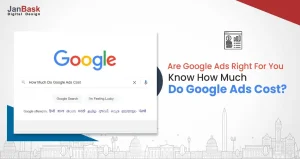












w
Great insights on creating an effective consulting website! Clear branding and user-friendly design are so important for building trust with potential clients. Thanks for sharing these valuable tips.
C
This lead generation blog is a goldmine of information! It offers a comprehensive guide on how to generate leads effectively, and the tips provided are practical and easy to implement.
J
Great post on lead generation strategies! Your insights on creating valuable content and optimizing landing pages are spot on.
Z
This blog is a goldmine of information for businesses seeking to generate inbound leads.
K
Social media plays a huge role in lead generation today. It would be great to see some tips on leveraging different platforms for this purpose.
K
Your tips on using social media and email marketing for lead generation are spot on.